en savoir plus

Permet à tous ses détenteurs d'obtenir 5% de réduction sur tous les livres lors du retrait en magasin (réduction non cumulable avec les réductions de type étudiant).
Offre également un certain nombre d'avantages auprès de nos partenaires.
Avec les favoris, retrouvez dans un espace les sélections effectuées au fur et à mesure de vos navigations dans le site.
Constituez pour votre usage personnel vos listes de livres en prévisions d'achats futurs et votre sélection d'articles, dossiers, événements, vidéos ou podcasts préférés ou à découvrir plus tard...
Il suffit simplement de cliquer sur "Ajout Favori" sur chaque page qui vous intéresse pour les retrouver ensuite dans votre espace personnel.
Requiert un compte Mollat
Requiert un compte Mollat
Across the line of speech and writing variation : proceedings of the 2nd International conference on linguistic and psycholinguistic approaches to text structuring (LPTS 2011)
Auteur : International conference on linguistic and psycholinguistic approaches to text structuring (2 ; 2011 ; Louvain-la-Neuve, Belgique)
en savoir plus
Résumé
Communications sur la structure du texte et du discours selon la perspective des variations du langage, en distinguant les modes parlés et écrits, ainsi que le degré de formalité impliqué. ©Electre 2025
Quatrième de couverture
Corpora and Language in use
The medium we use to communicate (oral, written, or even gestural) plays an important role in the way we structure and organize our discourse. To do this, we can draw on linguistic markers, such as connectives, discourse markers or frame markers, or on (marked) information structure constructions. What is the impact of the nature of the medium (spoken vs. written vs. gestural) and of the style of the discourse at hand (formal vs. informal) on the choice of one linguistic expression over the other ? While medium seems to play a role in the discrimination between text types (e.g., casual coffee conversation between colleagues, business meeting, e-novel), it is less clear what the potential impact is of extra-linguistic parameters, such as emotional weight or spatiotemporal distance between the interlocutors, on the structuring of those texts. These questions bring us face to face with the limits of the traditional dichotomic representation opposing speech and writing on the sole basis of the medium at hand. The contributions in this volume follow the suggestion to consider discourse structure not only from the perspective of variation between the written and the spoken mode, but also from the perspective of variation on a continuum from formal to informal ways of communicating.
Fiche Technique
Paru le : 26/12/2013
Thématique : Linguistique
Auteur(s) : Auteur : International conference on linguistic and psycholinguistic approaches to text structuring (2 ; 2011 ; Louvain-la-Neuve, Belgique)
Éditeur(s) :
Presses universitaires de Louvain
Collection(s) : Corpora and language in use
Contributeur(s) : Editeur scientifique (ou intellectuel) : Catherine Bolly - Editeur scientifique (ou intellectuel) : Liesbeth Degand
Série(s) : Non précisé.
ISBN : 978-2-87558-220-1
EAN13 : 9782875582201
Reliure : Broché
Pages : 212
Hauteur: 25.0 cm / Largeur 16.0 cm
Poids: 501 g

